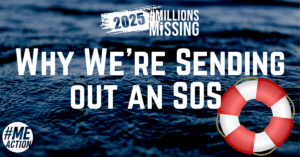Government funding for research centers and a data management center for ME/CFS has been made public, and the amount of funding allocated is infuriatingly small.
The National Institute of Health (NIH) plans to issue two Requests for Application (RFAs) in January to fund 2-3 collaborative research centers and a data management center for ME/CFS. The RFAs will provide a total of $30 million over the next 5 years, or approximately $6 million per year. It is not yet clear how the funding will be allocated between the research centers but, if spread evenly, the funding amounts to approximately $2 million per year per center – about the size of many NIH individual investigator awards.
The earliest that funding would begin is in September 2017.
Dr. Vicky Whittemore announced the funding for the RFAs at the Chronic Fatigue Syndrome Advisory Committee (CFSAC) meeting last week. Whittemore is a program director for the National Institute of Neurological Disorders and Stroke (NINDS) at the NIH, and a member of the Trans-NIH ME/CFS Working Group.
Activist Jennie Spotila welcomes the five-year commitment, but says the dollar amount is grossly inadequate because people with ME/CFS have suffered for decades while NIH refused to invest in research into the cause and treatment of the disease.
“When you are starving to death on a cup of rice a day, the addition of another cup of rice sounds like a banquet, but you are still going to starve to death.”
Scientists and activists have long called on the NIH to issue RFAs in order to attract researchers driven away by the stigma and lack of funding. RFAs come with set-aside funding. The last time NIH issued an RFA for ME/CFS was in 2005.
NIH has indicated that the total funding for ME/CFS research in 2017, including the new RFAs, will be about $15M. This level of funding is far below what would be expected based on the disease burden of people with ME/CFS, and it is far less than other disease groups receive.
In November 2015, during a call with patients and advocates, NINDS Director Walter Koroshetz said the RFA for ME/CFS research centers would be comparable in size to RFA’s establishing other research centers. A look at other similar initiatives in recent years shows malaria research centers receiving $14 million per year, autism research centers receiving $100 million over 5 years, and Fragile X research centers receiving $35 million over 5 years for a condition far less prevalent than ME/CFS.
Six million dollars per year for ME/CFS is not comparable to other recent research center initiatives.
The Open Medicine Foundation “wants to raise at least $5 million a year for research. An actual center will cost $10 million a year at least,” said foundation president Linda Tannenbaum.
Thus NIH’s proposed funds for the RFAs will not even pay for one center, let alone multiple research centers and a Data Management and Coordinating Center.
The ME community is tired of false starts. Director of NIH Francis Collins said in an interview with NPR in 2015 that funding for ME/CFS will be substantially greater than the current five or six million a year,” and that “we are going to ramp this up.” The expected $15 million in 2017 research funding is far below the NIH funding levels seen in other diseases of similar disease burden and also far below the $188 million per year that a recent paper estimated would be commensurate with ME/CFS’s burden.
Terri Wilder, a New York ME activist, is frustrated with the RFA dollar amount. “How much longer do we have to wait for our disease to be taken seriously? 30 years? 40 years? 100 years? While the RFA announcement is a step in the right direction, the dollar amount is crumbs compared to what we really need to uncover the basic science of this disease. This is exactly why the average American has a negative view of the government. We are let down at every turn.”
Meanwhile, Collins will continue as director of the NIH under the Trump administration for the time being, but it is not clear for how long, according to Science Magazine.
ME activists will continue to demand that the NIH fund research at a serious level and will fight louder and harder in 2017.
#NIHFUNDME
#FIGHTME
#NIHFORGETSME
#SERIOUSMONEYNOW

SOS: Save our Science
People disabled by ME and Long Covid across the UK send out an SOS. It’s time to send out our SOS signal, if we want to have funded research. May 12th, is Myalgic Encephalomyelitis Awareness Day. On this day, the #MillionsMissing of people with myalgic encephalomyelitis (ME) gather to demand an increase in research and




6 thoughts on “Funding for U.S. research centers falls way short”
We should demand more and will demand more but look at this in context.
Malaria is one of the scourges of the world – there’s no surprise it’s getting $100 millon over five years to research it. Fragile X affects many fewer people than ME/CFS and its already getting $40 million. Our research centers will be getting roughly the same amount of funding as Fragile X syndrome funding.
This is not at all to state that the amount given was enough but t simply acknowledge where we are. We’re not a well-known disease like malaria; we’re not close to Fragile X Syndrome in funding. Our researchers are hardly submitting any grants for ME/FS funding at all (@15 a year). We don’t the name recognition or the huge advocacy network that autism has. Comparing us to these diseases is like comparing apples to oranges.
Is it enough? Of course not. We should be getting 20 times what we’re getting. In the end, however, Francis Collins did significantly increase ME/CFS funding (it about doubled).
I think we should face the music about funding – it’s going to take years to get ME/CFS funding to where it should be. As much as we would like it to the NIH is not going to immediately pump $50 or $100 million into this disease. If we keep the pressure up in a couple years, though, we could be at $20 million and then $30 million and so on.
(I doubt that the NIH is going throw any real money at a disease where its researchers are only apply 15 grants a year, which is why we need a general RFA – not just for research centers – but look at how long it’s taken to get this one.).
That kind of rapid increase in funding would actually be quite rare for the NIH. It will take strong advocacy to get there. It’s obviously a very conservative Institution.
If there’s a real breakthrough things could happen more quickly but this will take a long term commitment and we shouldn’t expect otherwise.
So far as I can tell only in very rare situations does the NIH suddenly throw a lot of money at a disease. Maybe we will be the exception – I hope so. It certainly could triple our funding without spending a lot of money…
In response to Cort’s comments…
I agree – lets not compare apples and oranges. The denial and neglect of this disease for thirty years is outrageous. Patients have lost decades of their lives, left to suffer from not only the terrible debility of the disease but the disdain and disbelief of their doctors and the public at large. Have these other diseases experienced that? Is the ecosystem of researchers, pharma, and medical providers that drives new treatments and clinical care in this country as broken for those diseases as it is for ME?
Fixing the hole that ME is in today in a timescale that matters to patients is going to require a far greater commitment in funding and focus and a much greater sense of urgency from top leadership at both NIH and CDC than we have seen to date.
I disagree that we have to “face the music on funding.” ME patients have been ignored and mistreated long enough. They should not have to wait for the slow crank of incremental change to dribble out a bit here and a piece there just because ME patients are too disabled to create a stink about it. Its time that the response of our government reflects both the awful debility of this disease and the damage done by HHS’ own neglect and stigma for many years. We can not accept any less.
Brilliantly stated, Mary!
I concur 100% with everything you said. Thank you for speaking out, as many of us are too sick to respond so articulately.
The NIH is fiddling while Rome burns.
I believe this will continue until we, the broad huge community that we now are, force it to stop. NIH behavior is only plausibly consistent with fiddling-until-forced as firm, de facto policy that they have no intention of fixing. If I’m wrong, please feel free to send me email.
There are doubtless many good people within NIH who have little influence on this policy. We can best empower them by pushing the top leadership HARD from outside.
Agreed. Look at autism. I imagine that autism advocacy has full time staffer and lobbyists working for them. That’s how they got their funding and that’s what we have to do.
It may seem insane or unrealistic to expect that a conservative institution like the NIH would suddenly throw 25 x the amount of its annual funding toward a specific disease, but me/cfs is unprecedented in a lot of ways. Cort is right, there’s no way to compare it equally with things like malaria. I think me/cfs is not an apple or orange, but an entirely tropical fruit that basically no ones has ever tried. (I’m not great with metaphors sorry) The fact is though, this disease and the way it’s been handled, or mishandled– the outright looking the other way for so long, the neglect, the misappropriation of funds, the proactive crusade by psychiatrists and “medical historians” STILL to this day trying to prove that it’s not even an actual disease while millions continue to suffer– it’s all unprecedented. No disease has been drug through the trenches like this one has, and that’s why I think we might stand as the exception and not the rule when it comes to adjustment of funding. It will have to be dramatic if it’s going achieve what we need it to. Our best scientists having to rally for Public charity on the weekends because the federal government doesn’t really buy this disease is just madness. We have to demand better. And maybe we’ll have eyes rolled at us the whole way, but I’m not giving up on continuing to ask for dramatically more research funds from the NIH, even if such a hike in allocated dollars is unforeseen. Nothing about this disease has been close to normal, and neither do I expect, will the movement for change be or the results we finally see in the end. I know I won’t stop until the number is much higher, or at least until it’s enough to get the job done. And to Mr. Trump, a cool 100 mil isn’t so much to ask for, right? It will require us all to fight, and I think that we can do it.
It will require us all to fight, and I think that we can do it.
Comments are closed.